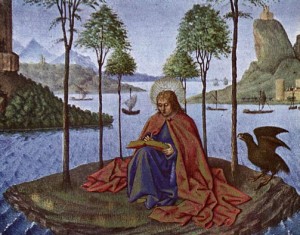The Word Made Fresh: the Second and Third Epistles of Saint John the Apostle
 “Anyone who is so ‘progressive’ as not to remain in the teaching of the Christ does not have God” (2 John 9).
“Anyone who is so ‘progressive’ as not to remain in the teaching of the Christ does not have God” (2 John 9).
Saint John the Apostle wrote of progressivism in his second letter 1,900 years ago. He directed his argument to the “lady elect and her children,” that is, to the community of believers who worked to preserve the truth about God’s only Son. By the end of the first century progressive Christians sought to pervert the truth and to make up new teaching as they went along.
These so-called ‘free thinkers’ remain in the church today. They sit on parish councils, run Catholic hospitals, schools and universities, and preach with forked tongues. The term “progressive” is a code word for liberalism much as “social justice” is a euphemism for liberal vengeance. The yahoos are out there, and they think their time has come.
In a way it has. Recent election results testify to this. As a priest in Massachusetts, I woke up last Wednesday confronted with the reality that my assembly and the presbyterate are filled with progressives. The clergy day I attended recently was no longer black and white but mostly blue and white and I felt pretty blue. The Commonwealth is the most Catholic state in the union and the most liberal state in the union. That is not a distinction of which to be proud.
There was no golden age of the church, not even during the apostolic age. The voice and tone of John’s letters comes off as confident and strong against adversity. The Word of God will not be gerrymandered. Scripture and Tradition work as one Truth with a capital “T” because they come from Divine Revelation (CCC 80). “Each of them makes present and fruitful in the Church the mystery of Christ, who promised to remain with his own, ‘even to the end of the age’” (cf Mt 28:20).
Saint John wrote three letters, known as 1, 2, and 3 John. He wrote to his communities, to encourage them to remain strong in the faith, to praise them for their adherence to the truth, and to warn them against false teaching.
The Second and Third Letters of John offer proof that great things come in small packages. These works, written toward the end of the Apostle’s life, are only 25 lines combined. Church Fathers hardly debated on their authenticity and they are included in the Canon because they were borne from the mind and the pen of the Beloved Disciple who wrote under the direction of the Holy Spirit for the Church long ago and today.
And the Word remains fresh.
The image conjured of the Beloved Disciple is first that of a young man leaning against his Savior’s breast at the Last Supper, and then as the Elder of whom it was said (but not by the Lord) that he would never die. Even in old age John vigorously defended the teachings of his Master, crucified, died, resurrected, and ascended so many decades earlier, against the lies of the “progressives” who denied the Truth and the authority of the Apostle.
As we conclude the liturgical year, 2 and 3 John make their rare and important appearances in the lectionary. These letters—referred to by Saint Jerome as “twin sisters”—appear only once in the three-year liturgical scriptural cycle: on Friday (2 John) and Saturday (3 John) of the 32nd Year of Ordinary Time Year II.
The message of 2 John is directed to “the chosen lady and her children,” probably an individual parish and its members. Whoever remains in the teaching of the Church has the love of God and the fullness of Divine Revelation. In 3 John the author commends a certain Gaius for his charity while admonishing a parish leader (possibly a blue-state priest?) named Diotrephes for “spreading evil nonsense against us” (10). This parish stood in danger of being infiltrated by heretics but the efforts of Gaius and another disciple named Demetrius helped the group survive the attacks of progressives from the inside and out and helped the church to survive.
John wrote 1, 2, and 3 John from Ephesus circa AD 100. First John appears prominently in the lectionary and in the Liturgy of the Hours, especially during Christmas and Easter. Minus a customary salutation, it reads less like a letter and more like a spiritual commentary on the fourth gospel. Similarities among the four Johannine works leave scholars with little doubt that these works were composed by the apostle himself or by scribes who worked closely with John in the Church.
It’s not always bad to be progressive, depending on which direction you’re progressing in, and to what end you wish to progress. The Church is growing, dynamic, created by a living God who reveals his will through his Word. Nothing can survive if it doesn’t grow or change yet the Word of God is neither flora, fauna, nor mineral but Spirit.
Second and Third John are the 24th and 25th books in the New Testament and the first and second shortest books in the entire Bible. Quantity is no indicator of quality. As with Scripture, sometimes less is more. Wherever you are, Lord, there is wisdom, there is truth (Ps 89).

